Audit Report: Financial Statement Review, Procedures & Audit Quality
VerifiedAdded on 2023/04/21
|12
|3168
|439
Report
AI Summary
This report provides an analysis of AMP Ltd's annual report for 2017, focusing on auditing and assurance. It includes an analytical review of the financial statements to identify areas of concern, such as liquidity risks indicated by the current ratio. The report formulates audit procedures to address these concerns, emphasizing the importance of Enterprise Risk Management (ERM). It also explores the concept of audit quality, highlighting the roles of IASB and ASIC in maintaining and improving audit standards in Australia. Three steps taken by Australian accounting bodies to improve audit quality are identified, including bridging the audit expectation gap, implementing audit regulations, and promoting financial reporting initiatives. The report concludes by emphasizing the significance of maintaining audit quality through continuous improvement and adherence to professional standards, ensuring accurate financial reporting and stakeholder confidence. Desklib provides access to this document and other solved assignments for students.
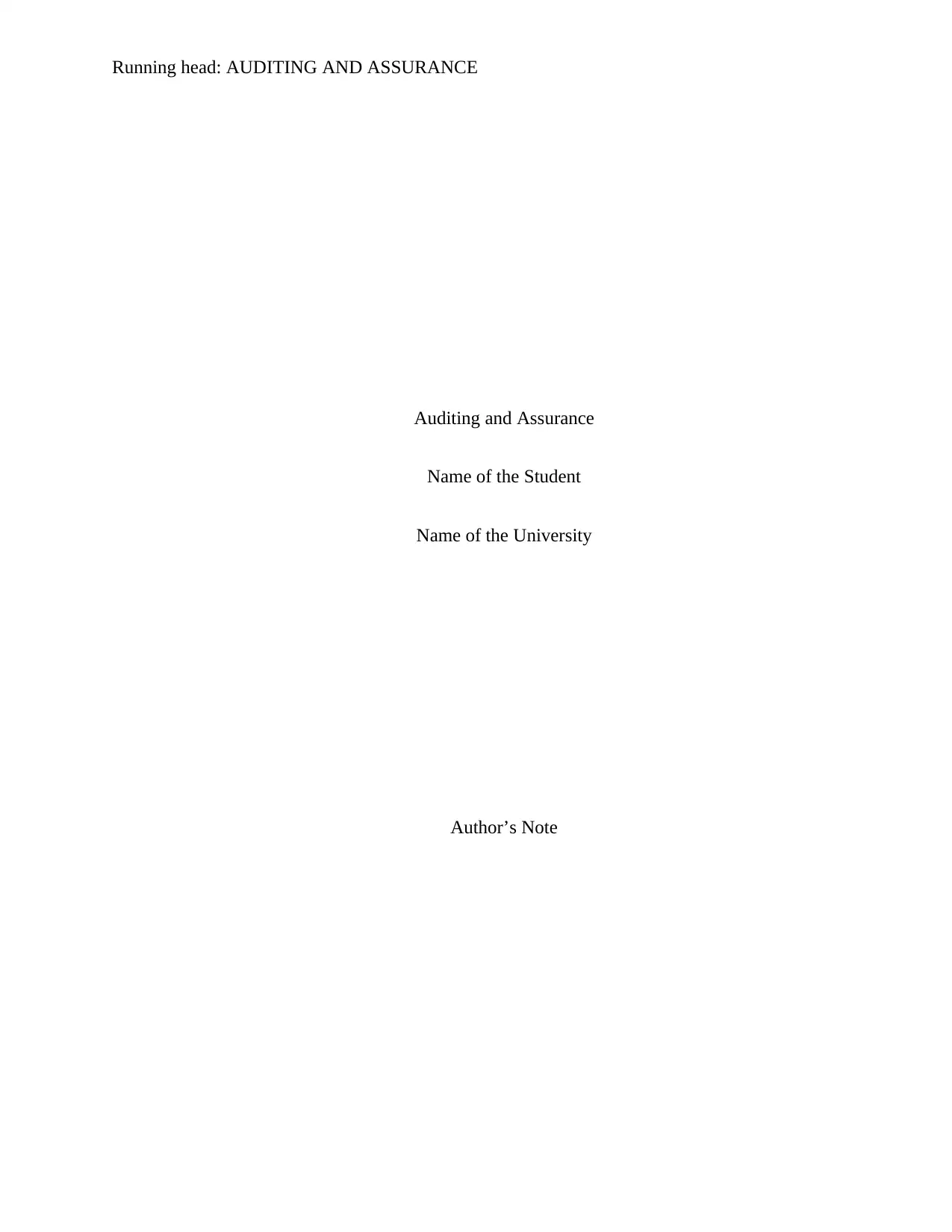
Running head: AUDITING AND ASSURANCE
Auditing and Assurance
Name of the Student
Name of the University
Author’s Note
Auditing and Assurance
Name of the Student
Name of the University
Author’s Note
Paraphrase This Document
Need a fresh take? Get an instant paraphrase of this document with our AI Paraphraser
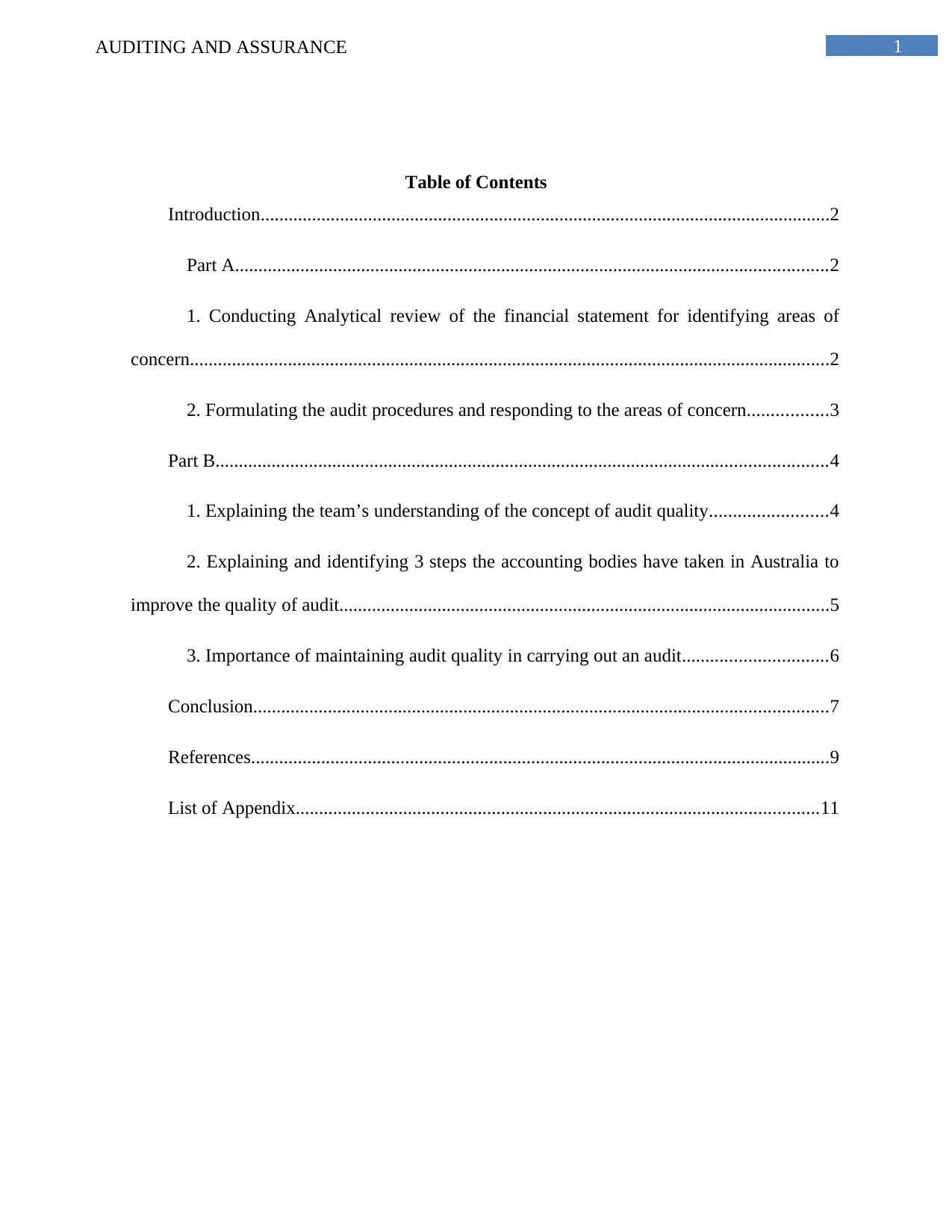
1AUDITING AND ASSURANCE
Table of Contents
Introduction..........................................................................................................................2
Part A...............................................................................................................................2
1. Conducting Analytical review of the financial statement for identifying areas of
concern.........................................................................................................................................2
2. Formulating the audit procedures and responding to the areas of concern.................3
Part B...................................................................................................................................4
1. Explaining the team’s understanding of the concept of audit quality.........................4
2. Explaining and identifying 3 steps the accounting bodies have taken in Australia to
improve the quality of audit.........................................................................................................5
3. Importance of maintaining audit quality in carrying out an audit...............................6
Conclusion...........................................................................................................................7
References............................................................................................................................9
List of Appendix................................................................................................................11
Table of Contents
Introduction..........................................................................................................................2
Part A...............................................................................................................................2
1. Conducting Analytical review of the financial statement for identifying areas of
concern.........................................................................................................................................2
2. Formulating the audit procedures and responding to the areas of concern.................3
Part B...................................................................................................................................4
1. Explaining the team’s understanding of the concept of audit quality.........................4
2. Explaining and identifying 3 steps the accounting bodies have taken in Australia to
improve the quality of audit.........................................................................................................5
3. Importance of maintaining audit quality in carrying out an audit...............................6
Conclusion...........................................................................................................................7
References............................................................................................................................9
List of Appendix................................................................................................................11
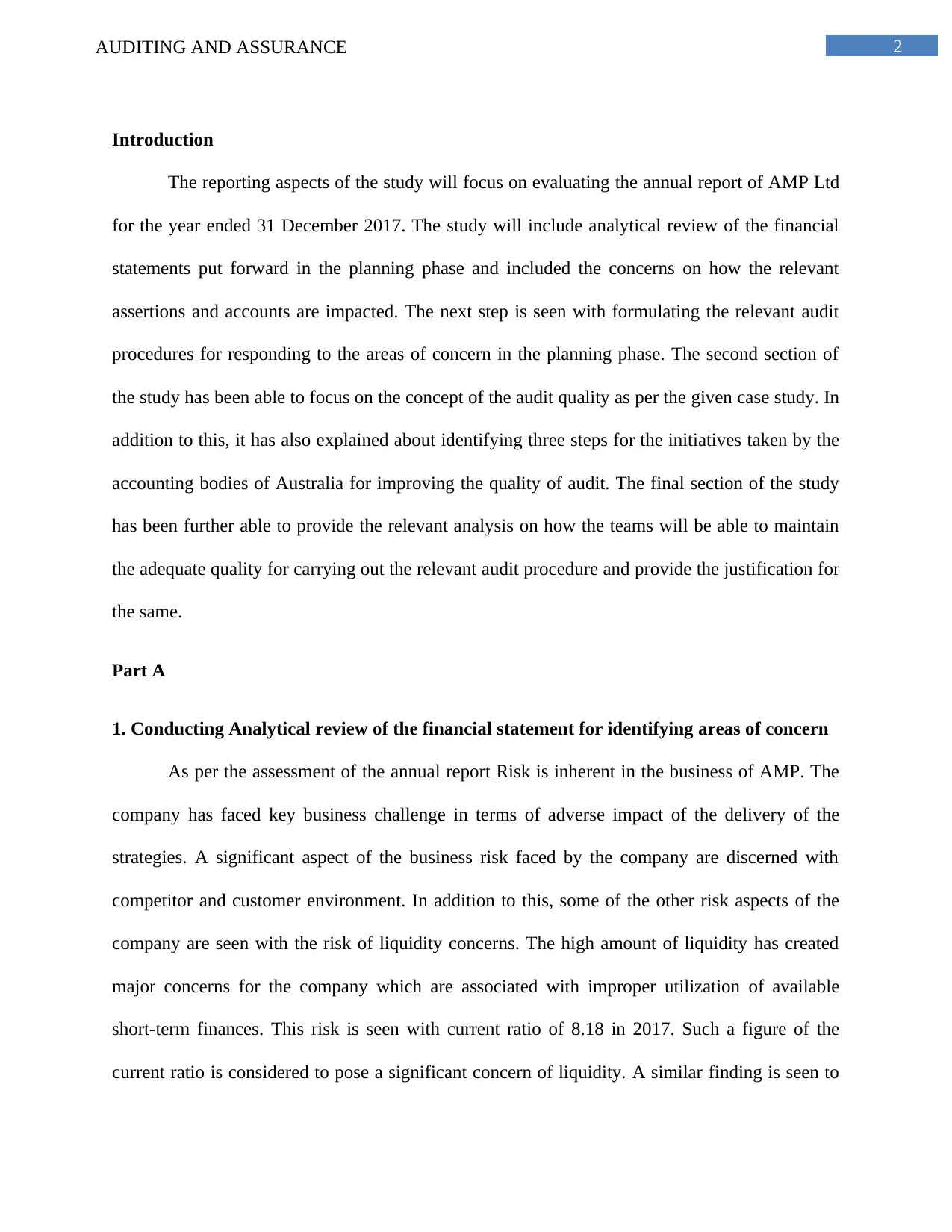
2AUDITING AND ASSURANCE
Introduction
The reporting aspects of the study will focus on evaluating the annual report of AMP Ltd
for the year ended 31 December 2017. The study will include analytical review of the financial
statements put forward in the planning phase and included the concerns on how the relevant
assertions and accounts are impacted. The next step is seen with formulating the relevant audit
procedures for responding to the areas of concern in the planning phase. The second section of
the study has been able to focus on the concept of the audit quality as per the given case study. In
addition to this, it has also explained about identifying three steps for the initiatives taken by the
accounting bodies of Australia for improving the quality of audit. The final section of the study
has been further able to provide the relevant analysis on how the teams will be able to maintain
the adequate quality for carrying out the relevant audit procedure and provide the justification for
the same.
Part A
1. Conducting Analytical review of the financial statement for identifying areas of concern
As per the assessment of the annual report Risk is inherent in the business of AMP. The
company has faced key business challenge in terms of adverse impact of the delivery of the
strategies. A significant aspect of the business risk faced by the company are discerned with
competitor and customer environment. In addition to this, some of the other risk aspects of the
company are seen with the risk of liquidity concerns. The high amount of liquidity has created
major concerns for the company which are associated with improper utilization of available
short-term finances. This risk is seen with current ratio of 8.18 in 2017. Such a figure of the
current ratio is considered to pose a significant concern of liquidity. A similar finding is seen to
Introduction
The reporting aspects of the study will focus on evaluating the annual report of AMP Ltd
for the year ended 31 December 2017. The study will include analytical review of the financial
statements put forward in the planning phase and included the concerns on how the relevant
assertions and accounts are impacted. The next step is seen with formulating the relevant audit
procedures for responding to the areas of concern in the planning phase. The second section of
the study has been able to focus on the concept of the audit quality as per the given case study. In
addition to this, it has also explained about identifying three steps for the initiatives taken by the
accounting bodies of Australia for improving the quality of audit. The final section of the study
has been further able to provide the relevant analysis on how the teams will be able to maintain
the adequate quality for carrying out the relevant audit procedure and provide the justification for
the same.
Part A
1. Conducting Analytical review of the financial statement for identifying areas of concern
As per the assessment of the annual report Risk is inherent in the business of AMP. The
company has faced key business challenge in terms of adverse impact of the delivery of the
strategies. A significant aspect of the business risk faced by the company are discerned with
competitor and customer environment. In addition to this, some of the other risk aspects of the
company are seen with the risk of liquidity concerns. The high amount of liquidity has created
major concerns for the company which are associated with improper utilization of available
short-term finances. This risk is seen with current ratio of 8.18 in 2017. Such a figure of the
current ratio is considered to pose a significant concern of liquidity. A similar finding is seen to
⊘ This is a preview!⊘
Do you want full access?
Subscribe today to unlock all pages.

Trusted by 1+ million students worldwide
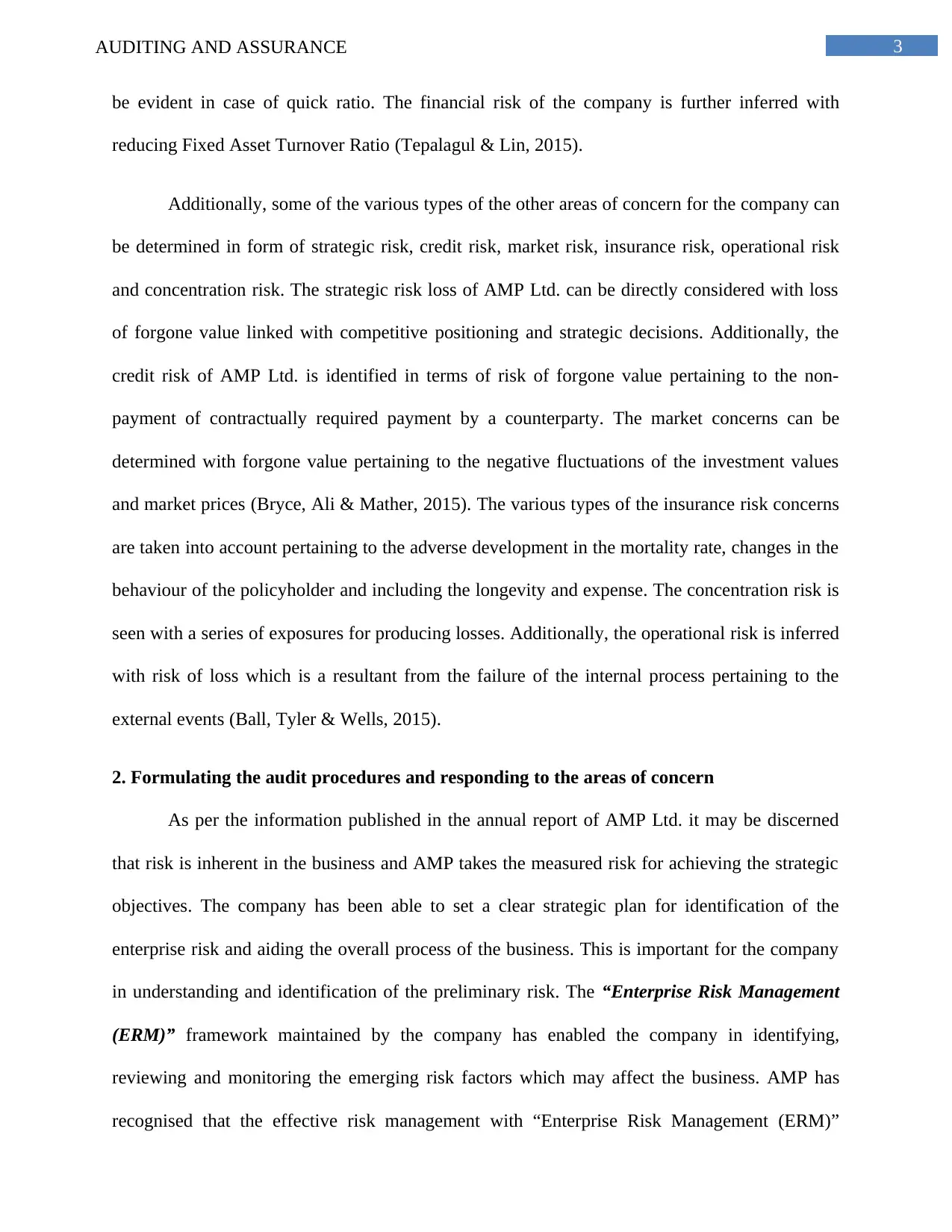
3AUDITING AND ASSURANCE
be evident in case of quick ratio. The financial risk of the company is further inferred with
reducing Fixed Asset Turnover Ratio (Tepalagul & Lin, 2015).
Additionally, some of the various types of the other areas of concern for the company can
be determined in form of strategic risk, credit risk, market risk, insurance risk, operational risk
and concentration risk. The strategic risk loss of AMP Ltd. can be directly considered with loss
of forgone value linked with competitive positioning and strategic decisions. Additionally, the
credit risk of AMP Ltd. is identified in terms of risk of forgone value pertaining to the non-
payment of contractually required payment by a counterparty. The market concerns can be
determined with forgone value pertaining to the negative fluctuations of the investment values
and market prices (Bryce, Ali & Mather, 2015). The various types of the insurance risk concerns
are taken into account pertaining to the adverse development in the mortality rate, changes in the
behaviour of the policyholder and including the longevity and expense. The concentration risk is
seen with a series of exposures for producing losses. Additionally, the operational risk is inferred
with risk of loss which is a resultant from the failure of the internal process pertaining to the
external events (Ball, Tyler & Wells, 2015).
2. Formulating the audit procedures and responding to the areas of concern
As per the information published in the annual report of AMP Ltd. it may be discerned
that risk is inherent in the business and AMP takes the measured risk for achieving the strategic
objectives. The company has been able to set a clear strategic plan for identification of the
enterprise risk and aiding the overall process of the business. This is important for the company
in understanding and identification of the preliminary risk. The “Enterprise Risk Management
(ERM)” framework maintained by the company has enabled the company in identifying,
reviewing and monitoring the emerging risk factors which may affect the business. AMP has
recognised that the effective risk management with “Enterprise Risk Management (ERM)”
be evident in case of quick ratio. The financial risk of the company is further inferred with
reducing Fixed Asset Turnover Ratio (Tepalagul & Lin, 2015).
Additionally, some of the various types of the other areas of concern for the company can
be determined in form of strategic risk, credit risk, market risk, insurance risk, operational risk
and concentration risk. The strategic risk loss of AMP Ltd. can be directly considered with loss
of forgone value linked with competitive positioning and strategic decisions. Additionally, the
credit risk of AMP Ltd. is identified in terms of risk of forgone value pertaining to the non-
payment of contractually required payment by a counterparty. The market concerns can be
determined with forgone value pertaining to the negative fluctuations of the investment values
and market prices (Bryce, Ali & Mather, 2015). The various types of the insurance risk concerns
are taken into account pertaining to the adverse development in the mortality rate, changes in the
behaviour of the policyholder and including the longevity and expense. The concentration risk is
seen with a series of exposures for producing losses. Additionally, the operational risk is inferred
with risk of loss which is a resultant from the failure of the internal process pertaining to the
external events (Ball, Tyler & Wells, 2015).
2. Formulating the audit procedures and responding to the areas of concern
As per the information published in the annual report of AMP Ltd. it may be discerned
that risk is inherent in the business and AMP takes the measured risk for achieving the strategic
objectives. The company has been able to set a clear strategic plan for identification of the
enterprise risk and aiding the overall process of the business. This is important for the company
in understanding and identification of the preliminary risk. The “Enterprise Risk Management
(ERM)” framework maintained by the company has enabled the company in identifying,
reviewing and monitoring the emerging risk factors which may affect the business. AMP has
recognised that the effective risk management with “Enterprise Risk Management (ERM)”
Paraphrase This Document
Need a fresh take? Get an instant paraphrase of this document with our AI Paraphraser
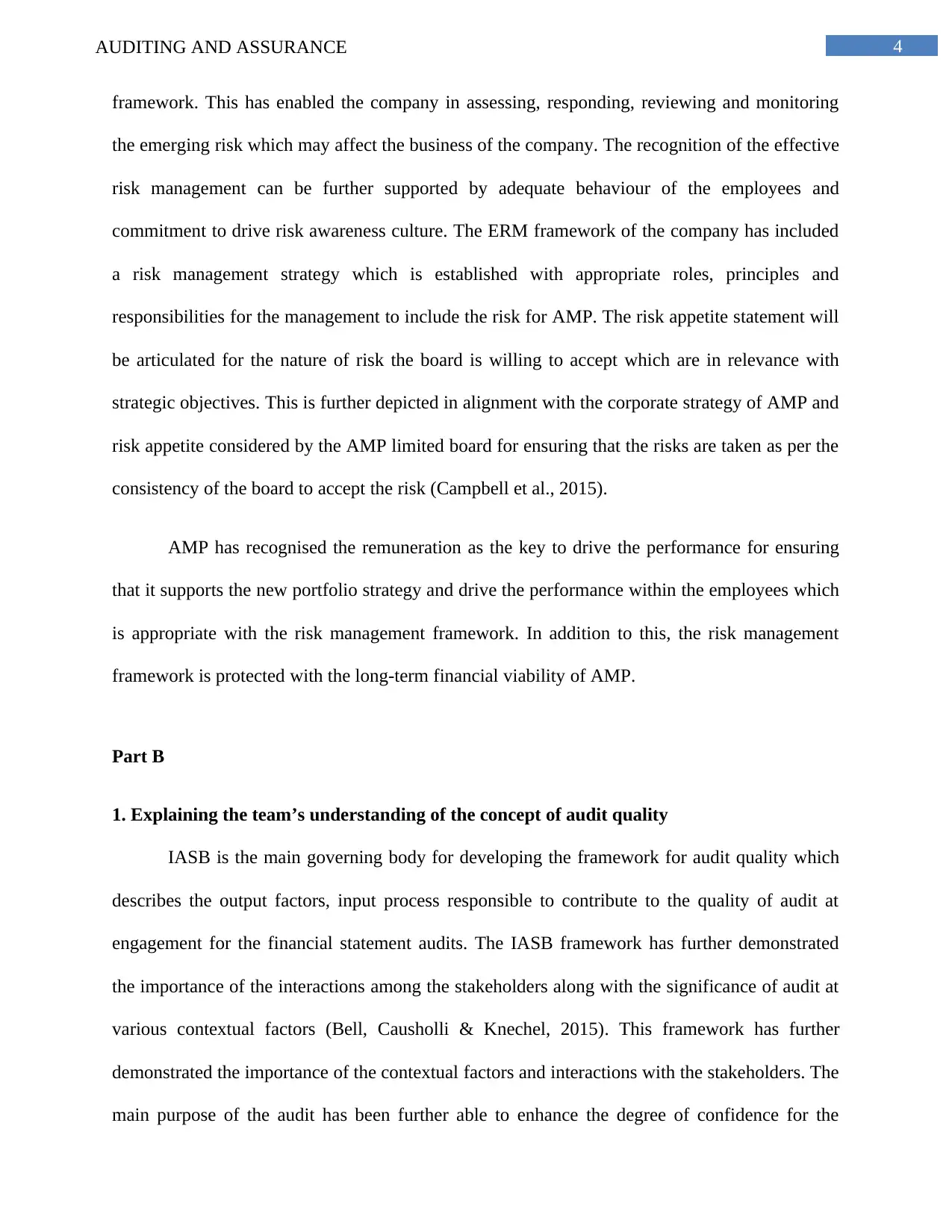
4AUDITING AND ASSURANCE
framework. This has enabled the company in assessing, responding, reviewing and monitoring
the emerging risk which may affect the business of the company. The recognition of the effective
risk management can be further supported by adequate behaviour of the employees and
commitment to drive risk awareness culture. The ERM framework of the company has included
a risk management strategy which is established with appropriate roles, principles and
responsibilities for the management to include the risk for AMP. The risk appetite statement will
be articulated for the nature of risk the board is willing to accept which are in relevance with
strategic objectives. This is further depicted in alignment with the corporate strategy of AMP and
risk appetite considered by the AMP limited board for ensuring that the risks are taken as per the
consistency of the board to accept the risk (Campbell et al., 2015).
AMP has recognised the remuneration as the key to drive the performance for ensuring
that it supports the new portfolio strategy and drive the performance within the employees which
is appropriate with the risk management framework. In addition to this, the risk management
framework is protected with the long-term financial viability of AMP.
Part B
1. Explaining the team’s understanding of the concept of audit quality
IASB is the main governing body for developing the framework for audit quality which
describes the output factors, input process responsible to contribute to the quality of audit at
engagement for the financial statement audits. The IASB framework has further demonstrated
the importance of the interactions among the stakeholders along with the significance of audit at
various contextual factors (Bell, Causholli & Knechel, 2015). This framework has further
demonstrated the importance of the contextual factors and interactions with the stakeholders. The
main purpose of the audit has been further able to enhance the degree of confidence for the
framework. This has enabled the company in assessing, responding, reviewing and monitoring
the emerging risk which may affect the business of the company. The recognition of the effective
risk management can be further supported by adequate behaviour of the employees and
commitment to drive risk awareness culture. The ERM framework of the company has included
a risk management strategy which is established with appropriate roles, principles and
responsibilities for the management to include the risk for AMP. The risk appetite statement will
be articulated for the nature of risk the board is willing to accept which are in relevance with
strategic objectives. This is further depicted in alignment with the corporate strategy of AMP and
risk appetite considered by the AMP limited board for ensuring that the risks are taken as per the
consistency of the board to accept the risk (Campbell et al., 2015).
AMP has recognised the remuneration as the key to drive the performance for ensuring
that it supports the new portfolio strategy and drive the performance within the employees which
is appropriate with the risk management framework. In addition to this, the risk management
framework is protected with the long-term financial viability of AMP.
Part B
1. Explaining the team’s understanding of the concept of audit quality
IASB is the main governing body for developing the framework for audit quality which
describes the output factors, input process responsible to contribute to the quality of audit at
engagement for the financial statement audits. The IASB framework has further demonstrated
the importance of the interactions among the stakeholders along with the significance of audit at
various contextual factors (Bell, Causholli & Knechel, 2015). This framework has further
demonstrated the importance of the contextual factors and interactions with the stakeholders. The
main purpose of the audit has been further able to enhance the degree of confidence for the
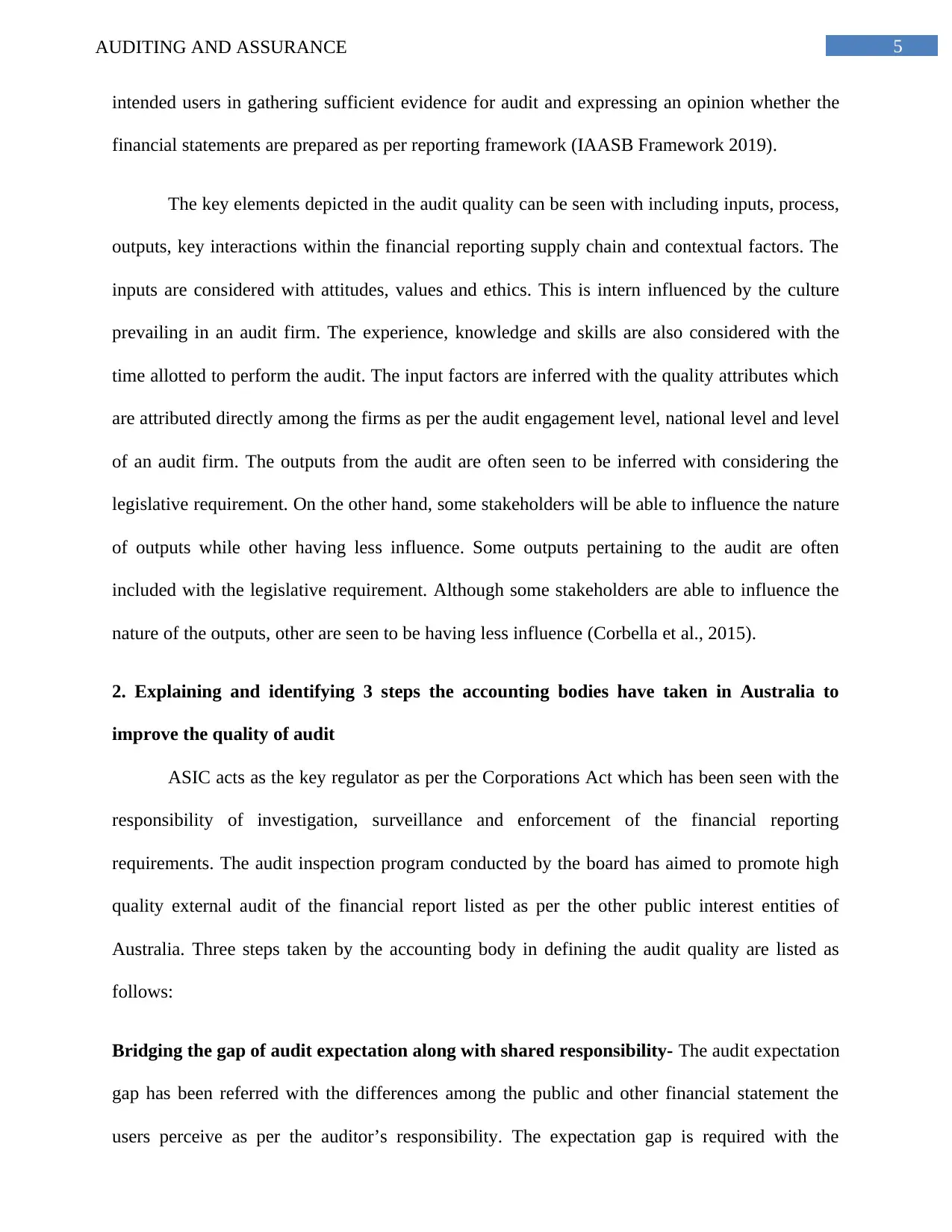
5AUDITING AND ASSURANCE
intended users in gathering sufficient evidence for audit and expressing an opinion whether the
financial statements are prepared as per reporting framework (IAASB Framework 2019).
The key elements depicted in the audit quality can be seen with including inputs, process,
outputs, key interactions within the financial reporting supply chain and contextual factors. The
inputs are considered with attitudes, values and ethics. This is intern influenced by the culture
prevailing in an audit firm. The experience, knowledge and skills are also considered with the
time allotted to perform the audit. The input factors are inferred with the quality attributes which
are attributed directly among the firms as per the audit engagement level, national level and level
of an audit firm. The outputs from the audit are often seen to be inferred with considering the
legislative requirement. On the other hand, some stakeholders will be able to influence the nature
of outputs while other having less influence. Some outputs pertaining to the audit are often
included with the legislative requirement. Although some stakeholders are able to influence the
nature of the outputs, other are seen to be having less influence (Corbella et al., 2015).
2. Explaining and identifying 3 steps the accounting bodies have taken in Australia to
improve the quality of audit
ASIC acts as the key regulator as per the Corporations Act which has been seen with the
responsibility of investigation, surveillance and enforcement of the financial reporting
requirements. The audit inspection program conducted by the board has aimed to promote high
quality external audit of the financial report listed as per the other public interest entities of
Australia. Three steps taken by the accounting body in defining the audit quality are listed as
follows:
Bridging the gap of audit expectation along with shared responsibility- The audit expectation
gap has been referred with the differences among the public and other financial statement the
users perceive as per the auditor’s responsibility. The expectation gap is required with the
intended users in gathering sufficient evidence for audit and expressing an opinion whether the
financial statements are prepared as per reporting framework (IAASB Framework 2019).
The key elements depicted in the audit quality can be seen with including inputs, process,
outputs, key interactions within the financial reporting supply chain and contextual factors. The
inputs are considered with attitudes, values and ethics. This is intern influenced by the culture
prevailing in an audit firm. The experience, knowledge and skills are also considered with the
time allotted to perform the audit. The input factors are inferred with the quality attributes which
are attributed directly among the firms as per the audit engagement level, national level and level
of an audit firm. The outputs from the audit are often seen to be inferred with considering the
legislative requirement. On the other hand, some stakeholders will be able to influence the nature
of outputs while other having less influence. Some outputs pertaining to the audit are often
included with the legislative requirement. Although some stakeholders are able to influence the
nature of the outputs, other are seen to be having less influence (Corbella et al., 2015).
2. Explaining and identifying 3 steps the accounting bodies have taken in Australia to
improve the quality of audit
ASIC acts as the key regulator as per the Corporations Act which has been seen with the
responsibility of investigation, surveillance and enforcement of the financial reporting
requirements. The audit inspection program conducted by the board has aimed to promote high
quality external audit of the financial report listed as per the other public interest entities of
Australia. Three steps taken by the accounting body in defining the audit quality are listed as
follows:
Bridging the gap of audit expectation along with shared responsibility- The audit expectation
gap has been referred with the differences among the public and other financial statement the
users perceive as per the auditor’s responsibility. The expectation gap is required with the
⊘ This is a preview!⊘
Do you want full access?
Subscribe today to unlock all pages.

Trusted by 1+ million students worldwide
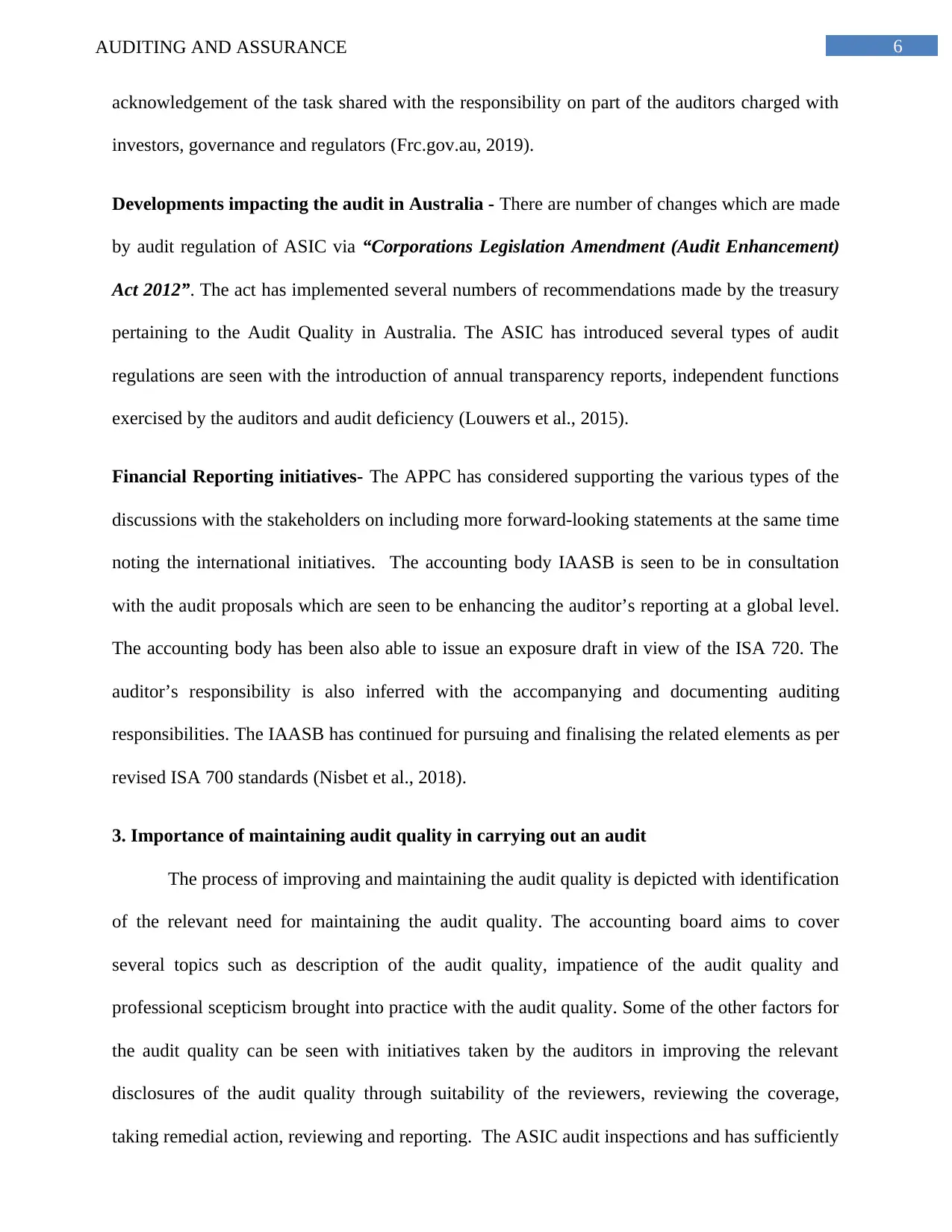
6AUDITING AND ASSURANCE
acknowledgement of the task shared with the responsibility on part of the auditors charged with
investors, governance and regulators (Frc.gov.au, 2019).
Developments impacting the audit in Australia - There are number of changes which are made
by audit regulation of ASIC via “Corporations Legislation Amendment (Audit Enhancement)
Act 2012”. The act has implemented several numbers of recommendations made by the treasury
pertaining to the Audit Quality in Australia. The ASIC has introduced several types of audit
regulations are seen with the introduction of annual transparency reports, independent functions
exercised by the auditors and audit deficiency (Louwers et al., 2015).
Financial Reporting initiatives- The APPC has considered supporting the various types of the
discussions with the stakeholders on including more forward-looking statements at the same time
noting the international initiatives. The accounting body IAASB is seen to be in consultation
with the audit proposals which are seen to be enhancing the auditor’s reporting at a global level.
The accounting body has been also able to issue an exposure draft in view of the ISA 720. The
auditor’s responsibility is also inferred with the accompanying and documenting auditing
responsibilities. The IAASB has continued for pursuing and finalising the related elements as per
revised ISA 700 standards (Nisbet et al., 2018).
3. Importance of maintaining audit quality in carrying out an audit
The process of improving and maintaining the audit quality is depicted with identification
of the relevant need for maintaining the audit quality. The accounting board aims to cover
several topics such as description of the audit quality, impatience of the audit quality and
professional scepticism brought into practice with the audit quality. Some of the other factors for
the audit quality can be seen with initiatives taken by the auditors in improving the relevant
disclosures of the audit quality through suitability of the reviewers, reviewing the coverage,
taking remedial action, reviewing and reporting. The ASIC audit inspections and has sufficiently
acknowledgement of the task shared with the responsibility on part of the auditors charged with
investors, governance and regulators (Frc.gov.au, 2019).
Developments impacting the audit in Australia - There are number of changes which are made
by audit regulation of ASIC via “Corporations Legislation Amendment (Audit Enhancement)
Act 2012”. The act has implemented several numbers of recommendations made by the treasury
pertaining to the Audit Quality in Australia. The ASIC has introduced several types of audit
regulations are seen with the introduction of annual transparency reports, independent functions
exercised by the auditors and audit deficiency (Louwers et al., 2015).
Financial Reporting initiatives- The APPC has considered supporting the various types of the
discussions with the stakeholders on including more forward-looking statements at the same time
noting the international initiatives. The accounting body IAASB is seen to be in consultation
with the audit proposals which are seen to be enhancing the auditor’s reporting at a global level.
The accounting body has been also able to issue an exposure draft in view of the ISA 720. The
auditor’s responsibility is also inferred with the accompanying and documenting auditing
responsibilities. The IAASB has continued for pursuing and finalising the related elements as per
revised ISA 700 standards (Nisbet et al., 2018).
3. Importance of maintaining audit quality in carrying out an audit
The process of improving and maintaining the audit quality is depicted with identification
of the relevant need for maintaining the audit quality. The accounting board aims to cover
several topics such as description of the audit quality, impatience of the audit quality and
professional scepticism brought into practice with the audit quality. Some of the other factors for
the audit quality can be seen with initiatives taken by the auditors in improving the relevant
disclosures of the audit quality through suitability of the reviewers, reviewing the coverage,
taking remedial action, reviewing and reporting. The ASIC audit inspections and has sufficiently
Paraphrase This Document
Need a fresh take? Get an instant paraphrase of this document with our AI Paraphraser
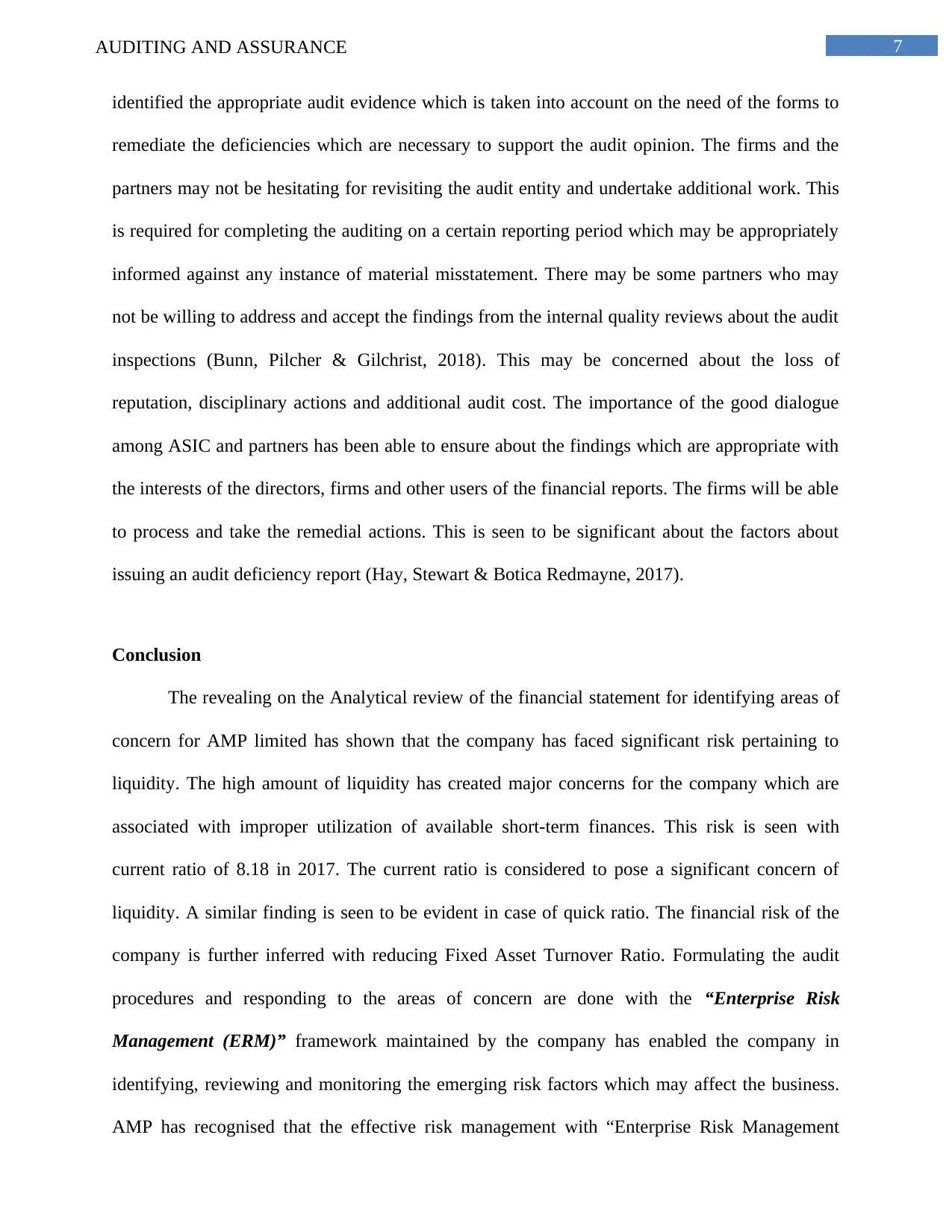
7AUDITING AND ASSURANCE
identified the appropriate audit evidence which is taken into account on the need of the forms to
remediate the deficiencies which are necessary to support the audit opinion. The firms and the
partners may not be hesitating for revisiting the audit entity and undertake additional work. This
is required for completing the auditing on a certain reporting period which may be appropriately
informed against any instance of material misstatement. There may be some partners who may
not be willing to address and accept the findings from the internal quality reviews about the audit
inspections (Bunn, Pilcher & Gilchrist, 2018). This may be concerned about the loss of
reputation, disciplinary actions and additional audit cost. The importance of the good dialogue
among ASIC and partners has been able to ensure about the findings which are appropriate with
the interests of the directors, firms and other users of the financial reports. The firms will be able
to process and take the remedial actions. This is seen to be significant about the factors about
issuing an audit deficiency report (Hay, Stewart & Botica Redmayne, 2017).
Conclusion
The revealing on the Analytical review of the financial statement for identifying areas of
concern for AMP limited has shown that the company has faced significant risk pertaining to
liquidity. The high amount of liquidity has created major concerns for the company which are
associated with improper utilization of available short-term finances. This risk is seen with
current ratio of 8.18 in 2017. The current ratio is considered to pose a significant concern of
liquidity. A similar finding is seen to be evident in case of quick ratio. The financial risk of the
company is further inferred with reducing Fixed Asset Turnover Ratio. Formulating the audit
procedures and responding to the areas of concern are done with the “Enterprise Risk
Management (ERM)” framework maintained by the company has enabled the company in
identifying, reviewing and monitoring the emerging risk factors which may affect the business.
AMP has recognised that the effective risk management with “Enterprise Risk Management
identified the appropriate audit evidence which is taken into account on the need of the forms to
remediate the deficiencies which are necessary to support the audit opinion. The firms and the
partners may not be hesitating for revisiting the audit entity and undertake additional work. This
is required for completing the auditing on a certain reporting period which may be appropriately
informed against any instance of material misstatement. There may be some partners who may
not be willing to address and accept the findings from the internal quality reviews about the audit
inspections (Bunn, Pilcher & Gilchrist, 2018). This may be concerned about the loss of
reputation, disciplinary actions and additional audit cost. The importance of the good dialogue
among ASIC and partners has been able to ensure about the findings which are appropriate with
the interests of the directors, firms and other users of the financial reports. The firms will be able
to process and take the remedial actions. This is seen to be significant about the factors about
issuing an audit deficiency report (Hay, Stewart & Botica Redmayne, 2017).
Conclusion
The revealing on the Analytical review of the financial statement for identifying areas of
concern for AMP limited has shown that the company has faced significant risk pertaining to
liquidity. The high amount of liquidity has created major concerns for the company which are
associated with improper utilization of available short-term finances. This risk is seen with
current ratio of 8.18 in 2017. The current ratio is considered to pose a significant concern of
liquidity. A similar finding is seen to be evident in case of quick ratio. The financial risk of the
company is further inferred with reducing Fixed Asset Turnover Ratio. Formulating the audit
procedures and responding to the areas of concern are done with the “Enterprise Risk
Management (ERM)” framework maintained by the company has enabled the company in
identifying, reviewing and monitoring the emerging risk factors which may affect the business.
AMP has recognised that the effective risk management with “Enterprise Risk Management
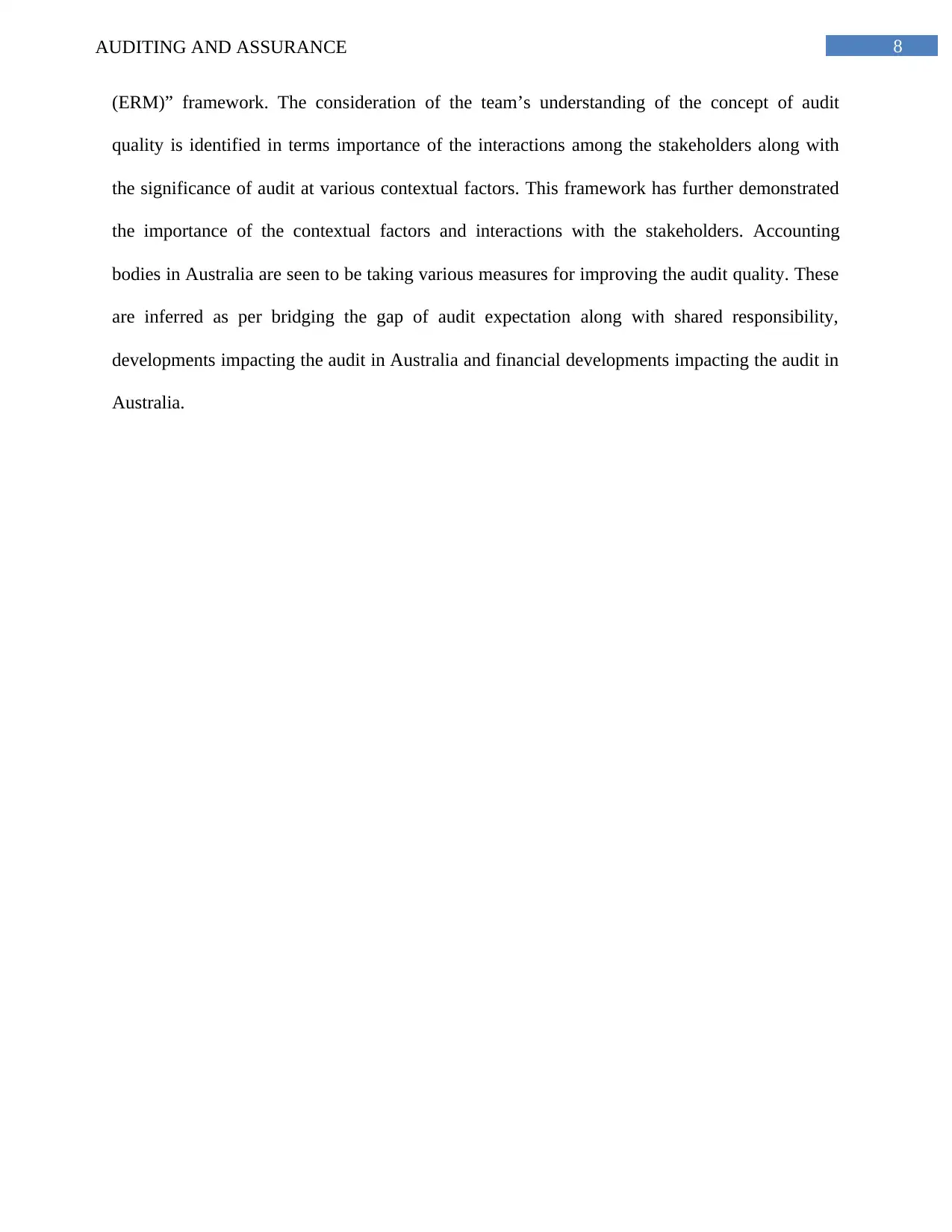
8AUDITING AND ASSURANCE
(ERM)” framework. The consideration of the team’s understanding of the concept of audit
quality is identified in terms importance of the interactions among the stakeholders along with
the significance of audit at various contextual factors. This framework has further demonstrated
the importance of the contextual factors and interactions with the stakeholders. Accounting
bodies in Australia are seen to be taking various measures for improving the audit quality. These
are inferred as per bridging the gap of audit expectation along with shared responsibility,
developments impacting the audit in Australia and financial developments impacting the audit in
Australia.
(ERM)” framework. The consideration of the team’s understanding of the concept of audit
quality is identified in terms importance of the interactions among the stakeholders along with
the significance of audit at various contextual factors. This framework has further demonstrated
the importance of the contextual factors and interactions with the stakeholders. Accounting
bodies in Australia are seen to be taking various measures for improving the audit quality. These
are inferred as per bridging the gap of audit expectation along with shared responsibility,
developments impacting the audit in Australia and financial developments impacting the audit in
Australia.
⊘ This is a preview!⊘
Do you want full access?
Subscribe today to unlock all pages.

Trusted by 1+ million students worldwide
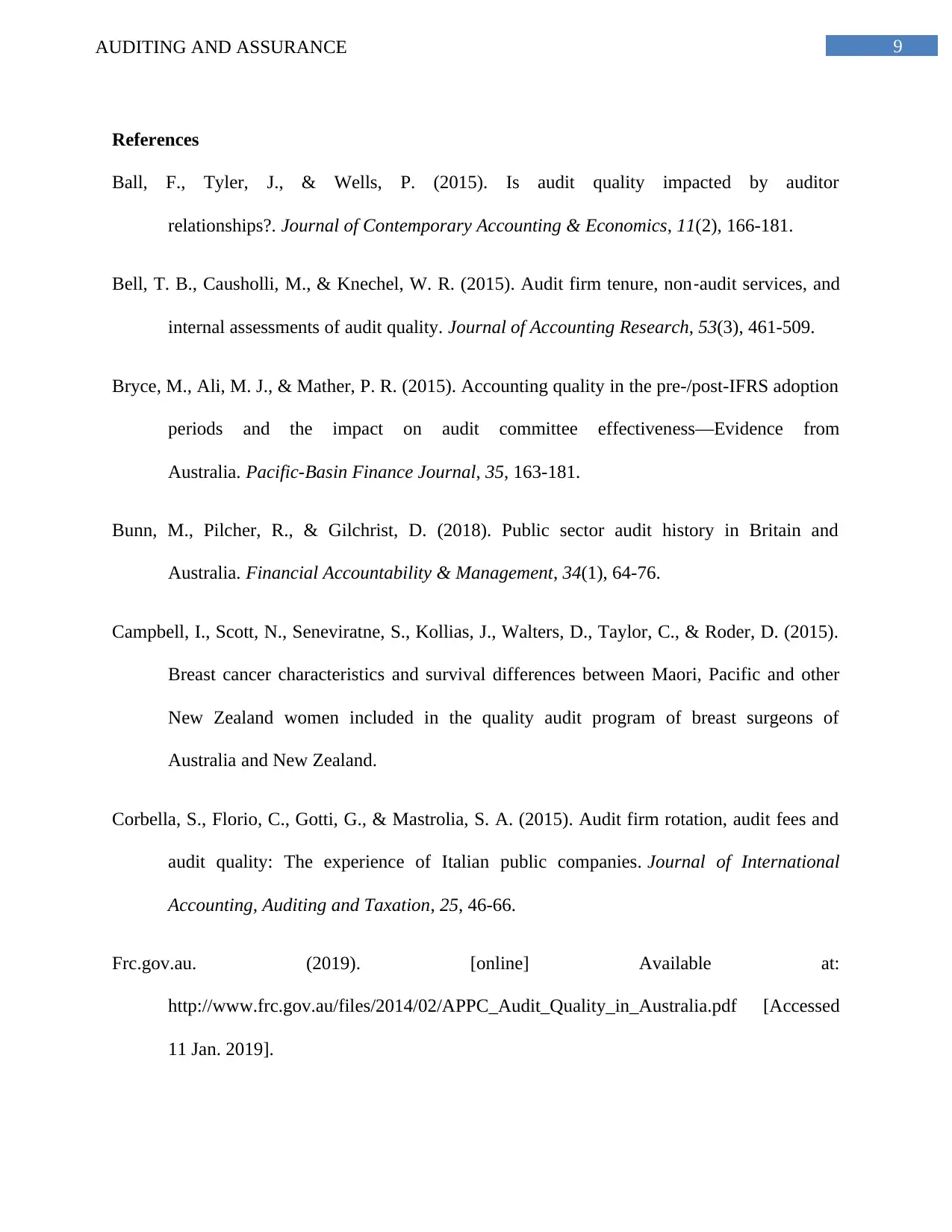
9AUDITING AND ASSURANCE
References
Ball, F., Tyler, J., & Wells, P. (2015). Is audit quality impacted by auditor
relationships?. Journal of Contemporary Accounting & Economics, 11(2), 166-181.
Bell, T. B., Causholli, M., & Knechel, W. R. (2015). Audit firm tenure, non‐audit services, and
internal assessments of audit quality. Journal of Accounting Research, 53(3), 461-509.
Bryce, M., Ali, M. J., & Mather, P. R. (2015). Accounting quality in the pre-/post-IFRS adoption
periods and the impact on audit committee effectiveness—Evidence from
Australia. Pacific-Basin Finance Journal, 35, 163-181.
Bunn, M., Pilcher, R., & Gilchrist, D. (2018). Public sector audit history in Britain and
Australia. Financial Accountability & Management, 34(1), 64-76.
Campbell, I., Scott, N., Seneviratne, S., Kollias, J., Walters, D., Taylor, C., & Roder, D. (2015).
Breast cancer characteristics and survival differences between Maori, Pacific and other
New Zealand women included in the quality audit program of breast surgeons of
Australia and New Zealand.
Corbella, S., Florio, C., Gotti, G., & Mastrolia, S. A. (2015). Audit firm rotation, audit fees and
audit quality: The experience of Italian public companies. Journal of International
Accounting, Auditing and Taxation, 25, 46-66.
Frc.gov.au. (2019). [online] Available at:
http://www.frc.gov.au/files/2014/02/APPC_Audit_Quality_in_Australia.pdf [Accessed
11 Jan. 2019].
References
Ball, F., Tyler, J., & Wells, P. (2015). Is audit quality impacted by auditor
relationships?. Journal of Contemporary Accounting & Economics, 11(2), 166-181.
Bell, T. B., Causholli, M., & Knechel, W. R. (2015). Audit firm tenure, non‐audit services, and
internal assessments of audit quality. Journal of Accounting Research, 53(3), 461-509.
Bryce, M., Ali, M. J., & Mather, P. R. (2015). Accounting quality in the pre-/post-IFRS adoption
periods and the impact on audit committee effectiveness—Evidence from
Australia. Pacific-Basin Finance Journal, 35, 163-181.
Bunn, M., Pilcher, R., & Gilchrist, D. (2018). Public sector audit history in Britain and
Australia. Financial Accountability & Management, 34(1), 64-76.
Campbell, I., Scott, N., Seneviratne, S., Kollias, J., Walters, D., Taylor, C., & Roder, D. (2015).
Breast cancer characteristics and survival differences between Maori, Pacific and other
New Zealand women included in the quality audit program of breast surgeons of
Australia and New Zealand.
Corbella, S., Florio, C., Gotti, G., & Mastrolia, S. A. (2015). Audit firm rotation, audit fees and
audit quality: The experience of Italian public companies. Journal of International
Accounting, Auditing and Taxation, 25, 46-66.
Frc.gov.au. (2019). [online] Available at:
http://www.frc.gov.au/files/2014/02/APPC_Audit_Quality_in_Australia.pdf [Accessed
11 Jan. 2019].
Paraphrase This Document
Need a fresh take? Get an instant paraphrase of this document with our AI Paraphraser
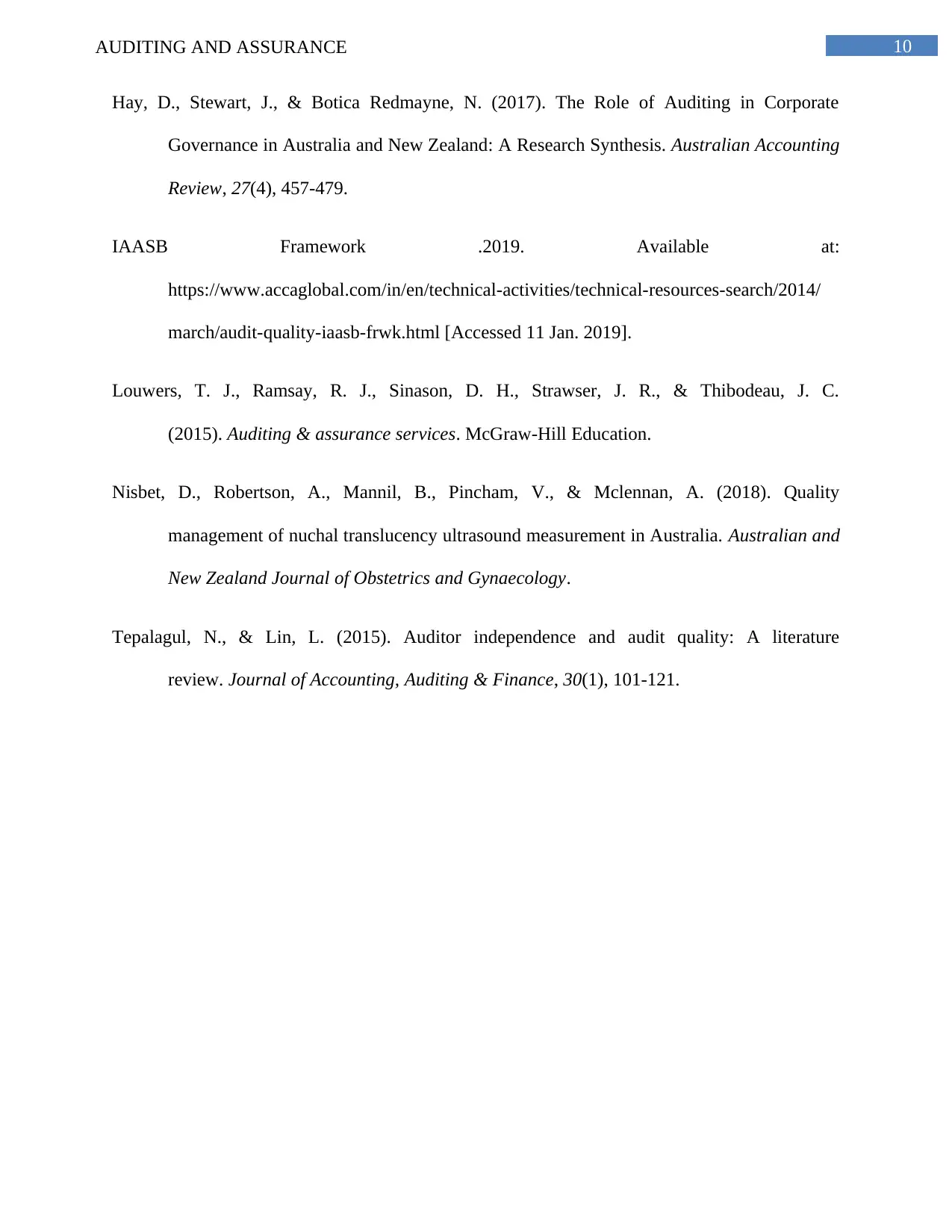
10AUDITING AND ASSURANCE
Hay, D., Stewart, J., & Botica Redmayne, N. (2017). The Role of Auditing in Corporate
Governance in Australia and New Zealand: A Research Synthesis. Australian Accounting
Review, 27(4), 457-479.
IAASB Framework .2019. Available at:
https://www.accaglobal.com/in/en/technical-activities/technical-resources-search/2014/
march/audit-quality-iaasb-frwk.html [Accessed 11 Jan. 2019].
Louwers, T. J., Ramsay, R. J., Sinason, D. H., Strawser, J. R., & Thibodeau, J. C.
(2015). Auditing & assurance services. McGraw-Hill Education.
Nisbet, D., Robertson, A., Mannil, B., Pincham, V., & Mclennan, A. (2018). Quality
management of nuchal translucency ultrasound measurement in Australia. Australian and
New Zealand Journal of Obstetrics and Gynaecology.
Tepalagul, N., & Lin, L. (2015). Auditor independence and audit quality: A literature
review. Journal of Accounting, Auditing & Finance, 30(1), 101-121.
Hay, D., Stewart, J., & Botica Redmayne, N. (2017). The Role of Auditing in Corporate
Governance in Australia and New Zealand: A Research Synthesis. Australian Accounting
Review, 27(4), 457-479.
IAASB Framework .2019. Available at:
https://www.accaglobal.com/in/en/technical-activities/technical-resources-search/2014/
march/audit-quality-iaasb-frwk.html [Accessed 11 Jan. 2019].
Louwers, T. J., Ramsay, R. J., Sinason, D. H., Strawser, J. R., & Thibodeau, J. C.
(2015). Auditing & assurance services. McGraw-Hill Education.
Nisbet, D., Robertson, A., Mannil, B., Pincham, V., & Mclennan, A. (2018). Quality
management of nuchal translucency ultrasound measurement in Australia. Australian and
New Zealand Journal of Obstetrics and Gynaecology.
Tepalagul, N., & Lin, L. (2015). Auditor independence and audit quality: A literature
review. Journal of Accounting, Auditing & Finance, 30(1), 101-121.
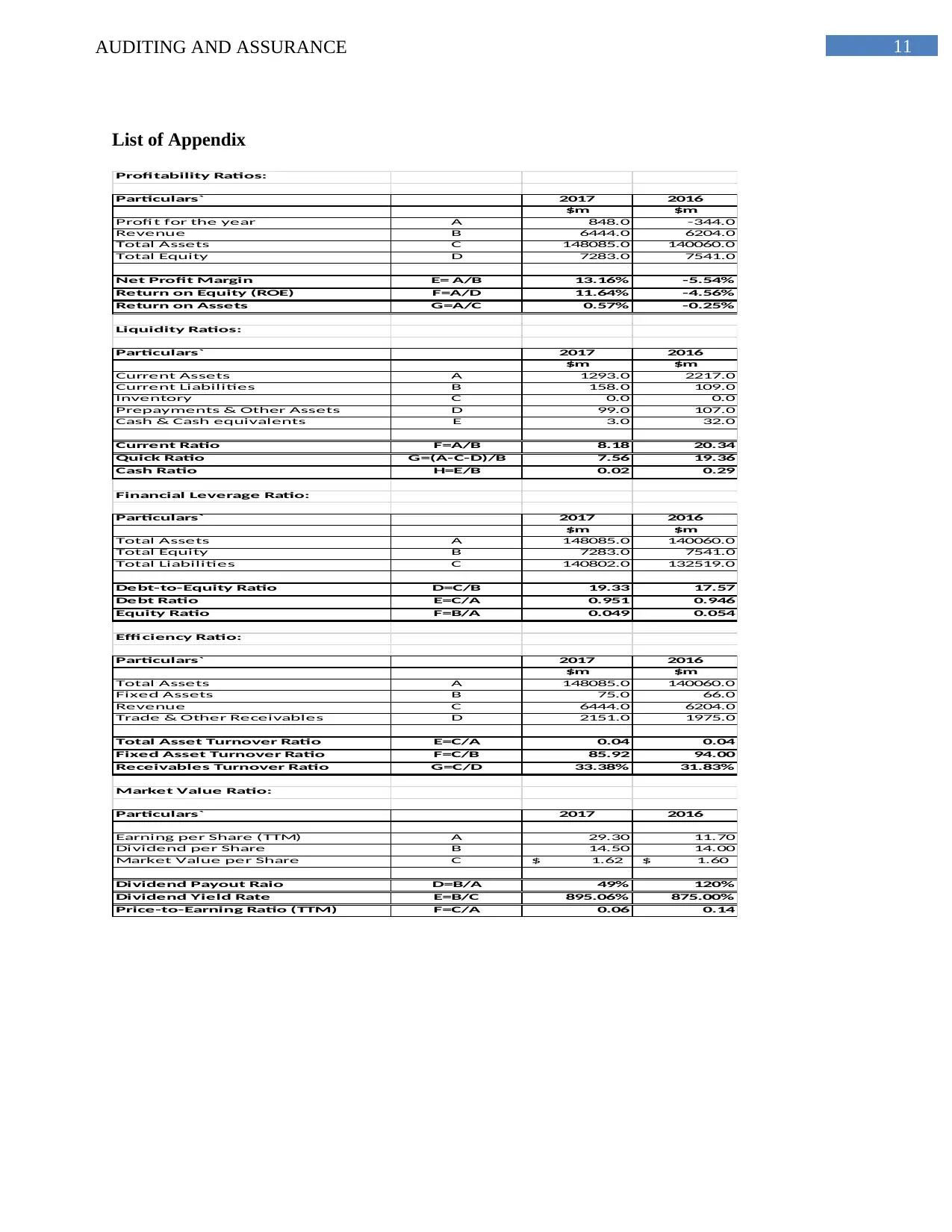
11AUDITING AND ASSURANCE
List of Appendix
Profitability Ratios:
Particulars` 2017 2016
$m $m
Profit for the year A 848.0 -344.0
Revenue B 6444.0 6204.0
Total Assets C 148085.0 140060.0
Total Equity D 7283.0 7541.0
Net Profit Margin E= A/B 13.16% -5.54%
Return on Equity (ROE) F=A/D 11.64% -4.56%
Return on Assets G=A/C 0.57% -0.25%
Liquidity Ratios:
Particulars` 2017 2016
$m $m
Current Assets A 1293.0 2217.0
Current Liabilities B 158.0 109.0
Inventory C 0.0 0.0
Prepayments & Other Assets D 99.0 107.0
Cash & Cash equivalents E 3.0 32.0
Current Ratio F=A/B 8.18 20.34
Quick Ratio G=(A-C-D)/B 7.56 19.36
Cash Ratio H=E/B 0.02 0.29
Financial Leverage Ratio:
Particulars` 2017 2016
$m $m
Total Assets A 148085.0 140060.0
Total Equity B 7283.0 7541.0
Total Liabilities C 140802.0 132519.0
Debt-to-Equity Ratio D=C/B 19.33 17.57
Debt Ratio E=C/A 0.951 0.946
Equity Ratio F=B/A 0.049 0.054
Efficiency Ratio:
Particulars` 2017 2016
$m $m
Total Assets A 148085.0 140060.0
Fixed Assets B 75.0 66.0
Revenue C 6444.0 6204.0
Trade & Other Receivables D 2151.0 1975.0
Total Asset Turnover Ratio E=C/A 0.04 0.04
Fixed Asset Turnover Ratio F=C/B 85.92 94.00
Receivables Turnover Ratio G=C/D 33.38% 31.83%
Market Value Ratio:
Particulars` 2017 2016
Earning per Share (TTM) A 29.30 11.70
Dividend per Share B 14.50 14.00
Market Value per Share C 1.62$ 1.60$
Dividend Payout Raio D=B/A 49% 120%
Dividend Yield Rate E=B/C 895.06% 875.00%
Price-to-Earning Ratio (TTM) F=C/A 0.06 0.14
List of Appendix
Profitability Ratios:
Particulars` 2017 2016
$m $m
Profit for the year A 848.0 -344.0
Revenue B 6444.0 6204.0
Total Assets C 148085.0 140060.0
Total Equity D 7283.0 7541.0
Net Profit Margin E= A/B 13.16% -5.54%
Return on Equity (ROE) F=A/D 11.64% -4.56%
Return on Assets G=A/C 0.57% -0.25%
Liquidity Ratios:
Particulars` 2017 2016
$m $m
Current Assets A 1293.0 2217.0
Current Liabilities B 158.0 109.0
Inventory C 0.0 0.0
Prepayments & Other Assets D 99.0 107.0
Cash & Cash equivalents E 3.0 32.0
Current Ratio F=A/B 8.18 20.34
Quick Ratio G=(A-C-D)/B 7.56 19.36
Cash Ratio H=E/B 0.02 0.29
Financial Leverage Ratio:
Particulars` 2017 2016
$m $m
Total Assets A 148085.0 140060.0
Total Equity B 7283.0 7541.0
Total Liabilities C 140802.0 132519.0
Debt-to-Equity Ratio D=C/B 19.33 17.57
Debt Ratio E=C/A 0.951 0.946
Equity Ratio F=B/A 0.049 0.054
Efficiency Ratio:
Particulars` 2017 2016
$m $m
Total Assets A 148085.0 140060.0
Fixed Assets B 75.0 66.0
Revenue C 6444.0 6204.0
Trade & Other Receivables D 2151.0 1975.0
Total Asset Turnover Ratio E=C/A 0.04 0.04
Fixed Asset Turnover Ratio F=C/B 85.92 94.00
Receivables Turnover Ratio G=C/D 33.38% 31.83%
Market Value Ratio:
Particulars` 2017 2016
Earning per Share (TTM) A 29.30 11.70
Dividend per Share B 14.50 14.00
Market Value per Share C 1.62$ 1.60$
Dividend Payout Raio D=B/A 49% 120%
Dividend Yield Rate E=B/C 895.06% 875.00%
Price-to-Earning Ratio (TTM) F=C/A 0.06 0.14
⊘ This is a preview!⊘
Do you want full access?
Subscribe today to unlock all pages.

Trusted by 1+ million students worldwide
1 out of 12
Related Documents
Your All-in-One AI-Powered Toolkit for Academic Success.
+13062052269
info@desklib.com
Available 24*7 on WhatsApp / Email
![[object Object]](/_next/static/media/star-bottom.7253800d.svg)
Unlock your academic potential
Copyright © 2020–2025 A2Z Services. All Rights Reserved. Developed and managed by ZUCOL.





